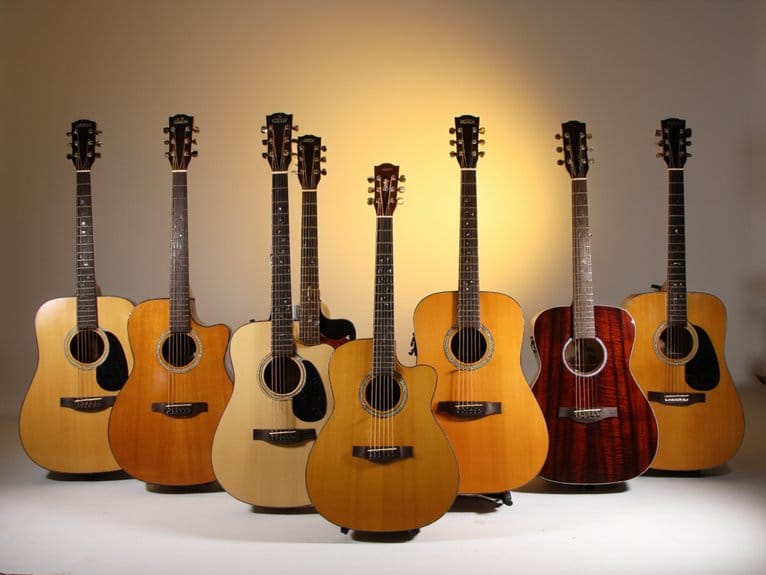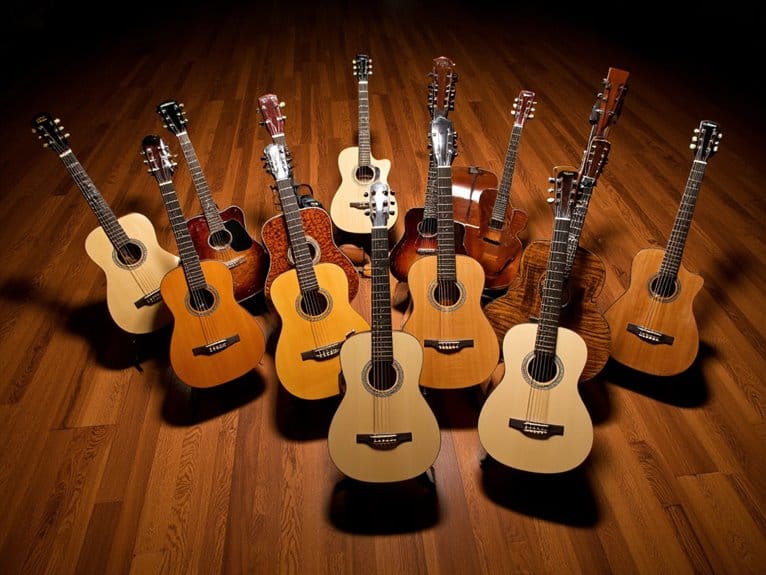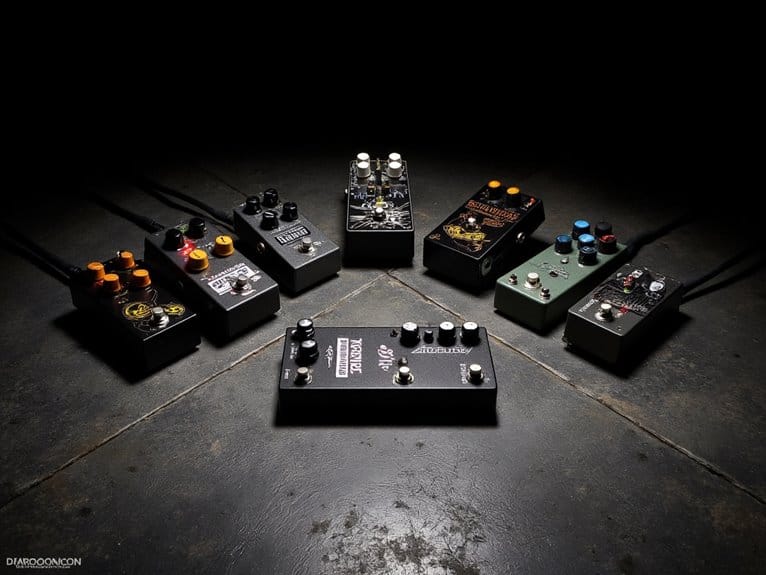Best Volume Guitar Pedals for Perfect Tone Control
I’ve tested dozens of volume pedals, and the top performers for 2025 include the SONICAKE Active Volume & Wah with its dual functionality and 100% analog circuitry, the Ernie Ball VP JR 250K featuring switchable taper rates and aluminum construction, and the Boss Stereo Volume Pedal for keyboardists needing dual inputs. The Hotone Volume Expression 2-in-1 saves pedalboard space, while Quick-Lok VP-2611 offers budget-friendly reliability. Each addresses specific impedance matching and signal preservation challenges that separate professional-grade from amateur setups.
We are supported by our audience. When you purchase through links on our site, we may earn an affiliate commission, at no extra cost for you. Learn more.
Notable Insights
- The SONICAKE Active Volume & Wah Pedal features 100% analog circuitry to prevent signal degradation and impedance issues.
- Ernie Ball VP JR 250K offers compact aluminum construction with micro taper switch for two distinct swell rates.
- Boss FV-50L provides stereo operation with dual inputs/outputs, making it ideal for keyboardists and professional applications.
- JIM DUNLOP DVP4 combines volume and expression functionality in a space-saving design with adjustable rocker tension.
- Budget-friendly options like Quick-Lok VP-2611 deliver reliable passive volume control without compromising essential tone adjustments.
SONICAKE Active Volume & Wah Pedal (VolWah)
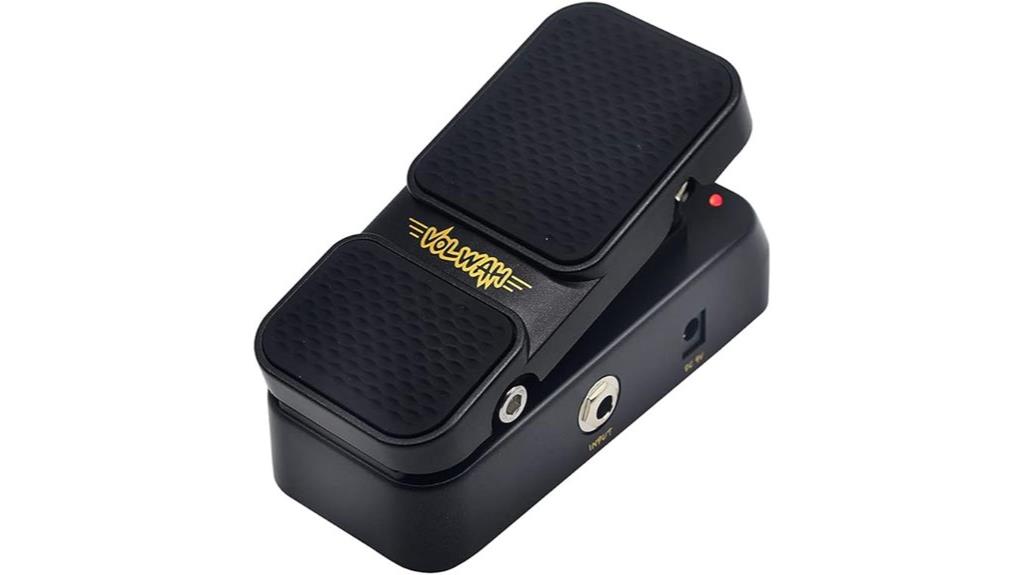
Guitar players who need maximum pedalboard efficiency will find the SONICAKE Active Volume & Wah Pedal (VolWah) solves two problems with one compact solution, combining essential volume control and classic wah functionality in a single mini enclosure. The 100% analog circuitry delivers vintage wah tones while preventing impedance mismatch through active volume control, which honestly saves you from those annoying signal degradation issues that plague passive designs. You’ll switch between modes using the hidden footswitch, with dual LED indicators clearly showing your current setting and engagement status. The lightweight yet robust construction fits snugly on crowded pedalboards, though you’ll need to source your own power adapter.
Best For: Guitar players with limited pedalboard space who need both essential volume control and classic wah effects in a single, compact pedal solution.
Pros:
- 100% analog circuitry with active volume control prevents impedance mismatch and signal degradation issues
- Space-saving 2-in-1 design combines volume and wah functions in a lightweight, robust mini enclosure
- Hidden footswitch mode selection with dual LED indicators for clear visual feedback of current mode and engagement status
Cons:
- Power adapter sold separately, requiring additional purchase for operation
- Hidden footswitch design may make mode switching less intuitive during live performance
- Limited to vintage wah sound style without additional tonal variations or customization options
Ernie Ball VP JR 250K Volume Pedal, For Passive Signals (P06180)
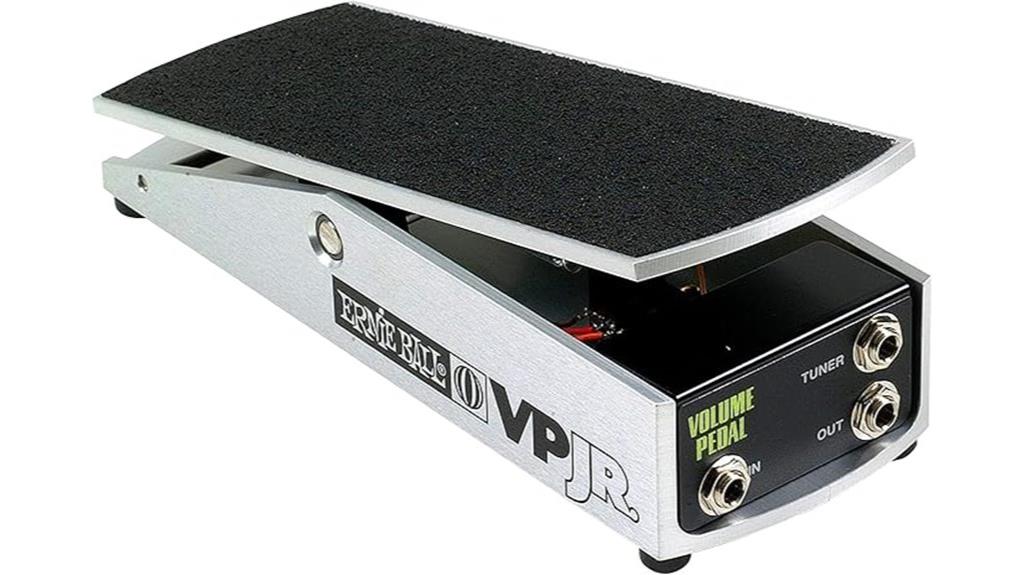
Compact pedal boards and tight stage setups demand gear that maximizes functionality without monopolizing valuable real estate, and I’ve found the Ernie Ball VP JR 250K delivers precisely that balance through its space-efficient 3.5″ x 10″ x 2.375″ aluminum construction. You’ll appreciate the precision-seated stainless steel pivot shaft that operates through nylon bushings, creating remarkably smooth action that rivals larger volume pedals. The 250k ohm potentiometer specifically accommodates passive pickups, while the micro taper switch provides two distinct swell rates for varied musical applications. At 1.32 pounds with impressive build quality that earned 4.7 stars from nearly 1,000 users, it’s become my reliable choice.
Best For: Musicians with compact pedalboards who need reliable volume control for passive pickup guitars and want smooth, professional-grade performance in a space-saving design.
Pros:
- Compact 3.5″ x 10″ footprint saves valuable pedalboard space while maintaining smooth, precise operation through stainless steel pivot shaft and nylon bushings
- Micro taper switch provides two distinct volume swell rates for versatile musical applications, plus tuner output for silent tuning
- Exceptional build quality with aluminum construction, Kevlar cable, and quick-disconnect wiring harness, backed by 4.7/5 star rating from nearly 1,000 users
Cons:
- 250k ohm potentiometer limits compatibility to passive pickups only, not suitable for active electronics
- Some users report minor issues with taper switch positioning affecting ease of use
- At $80+ price point, it’s more expensive than basic volume pedal alternatives
JIM DUNLOP Dunlop, / Volume X Mini Pedal (DVP4)
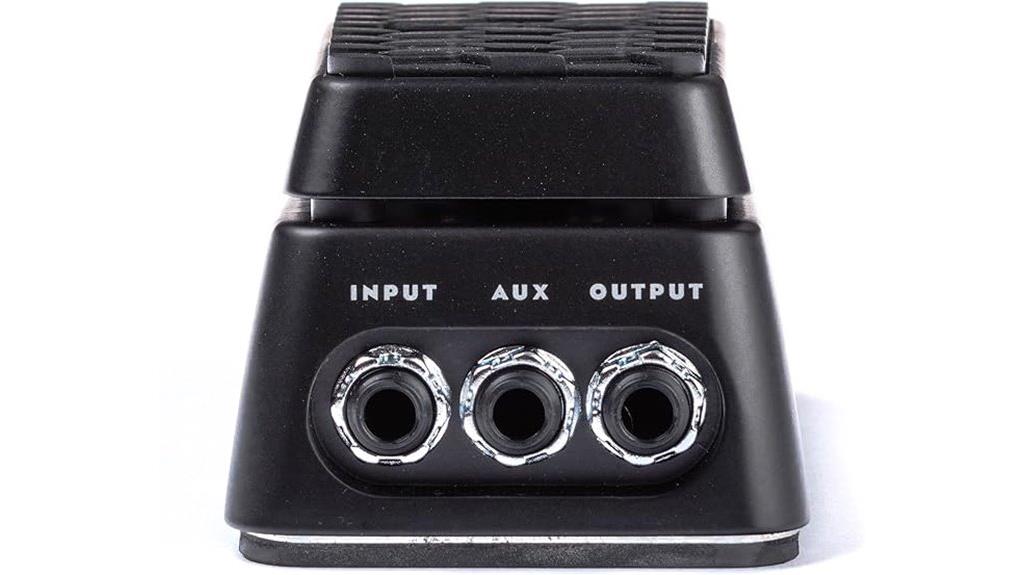
When pedalboard real estate becomes a premium commodity, the JIM DUNLOP Volume X Mini Pedal (DVP4) emerges as the space-saving champion that doesn’t compromise functionality for its diminutive footprint. At 6.73 x 3.43 x 3.39 inches, this lightweight aluminum chassis houses impressive versatility, featuring adjustable rocker tension, internal pot control for minimum expression levels, and the ability to reverse heel-down functions via internal switching. The low-friction band-drive mechanism delivers smooth operation while the aggressive non-slip tread guarantees stability during performance, though some users report occasional squeaking after extensive use that’s easily remedied with maintenance.
Best For: Musicians with limited pedalboard space who need a reliable, dual-purpose volume and expression pedal that offers professional functionality in a compact, travel-friendly form factor.
Pros:
- Compact design saves valuable pedalboard real estate while maintaining full functionality of larger volume pedals
- Versatile dual-purpose operation as both volume control and expression pedal with adjustable tension and reversible heel/toe functions
- Durable lightweight aluminum construction with smooth low-friction band-drive mechanism and non-slip tread for reliable performance
Cons:
- Some users experience mechanical issues like squeaking or static after extensive use requiring maintenance
- Smaller footprint may be less comfortable for players with larger feet compared to full-size volume pedals
- Requires TRS cables for expression functionality which may not be included with the pedal
Ernie Ball 40th Anniversary Volume Pedal (P06110)
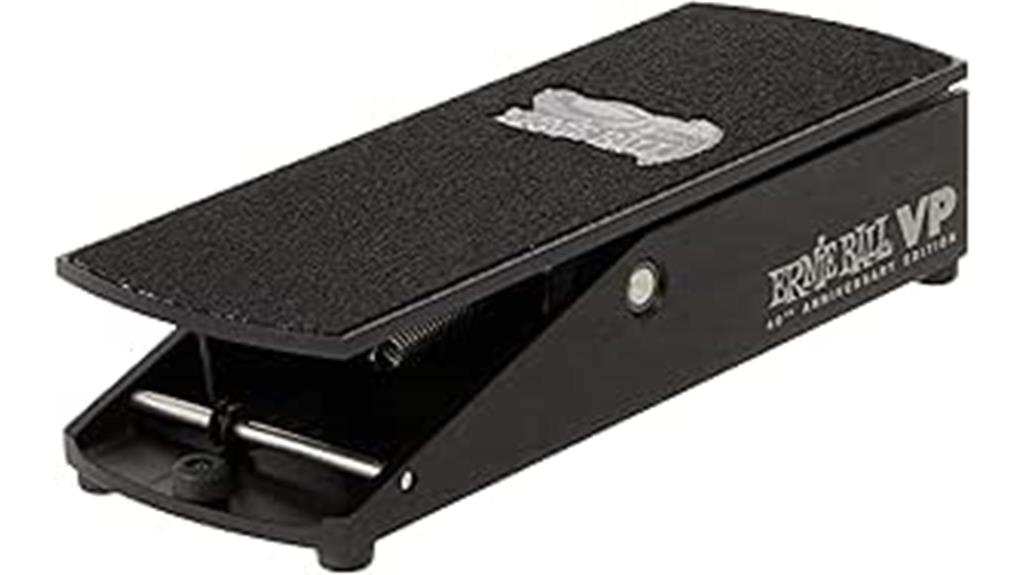
Celebrating four decades of musical innovation, the Ernie Ball 40th Anniversary Volume Pedal (P06110) stands out as the ideal choice for guitarists who value both heritage and functionality in their signal chain. This limited edition model features a sleek black finish that’ll complement any pedalboard setup, while its compact chassis won’t monopolize precious real estate. What impressed me most is the improved Kevlar cord, which delivers remarkably precise volume control that responds smoothly to your foot movements. The switchable taper function provides two distinct swell rates, letting you customize the pedal’s response curve to match your playing style. Since it requires no power, you’ll never worry about dead batteries mid-performance.
Best For: Guitarists seeking a reliable, heritage-inspired volume pedal with precise control and customizable response curves for studio or live performance use.
Pros:
- Improved Kevlar cord provides smooth, precise volume control with enhanced durability
- Switchable taper offers two distinct swell rates for customizable playing response
- No power required eliminates concerns about battery life or power supply dependencies
Cons:
- Limited edition status may result in higher pricing and restricted availability
- Compact size might be less comfortable for players with larger feet
- Lacks additional features like expression pedal functionality or tone shaping options
Boss Stereo Volume Pedal
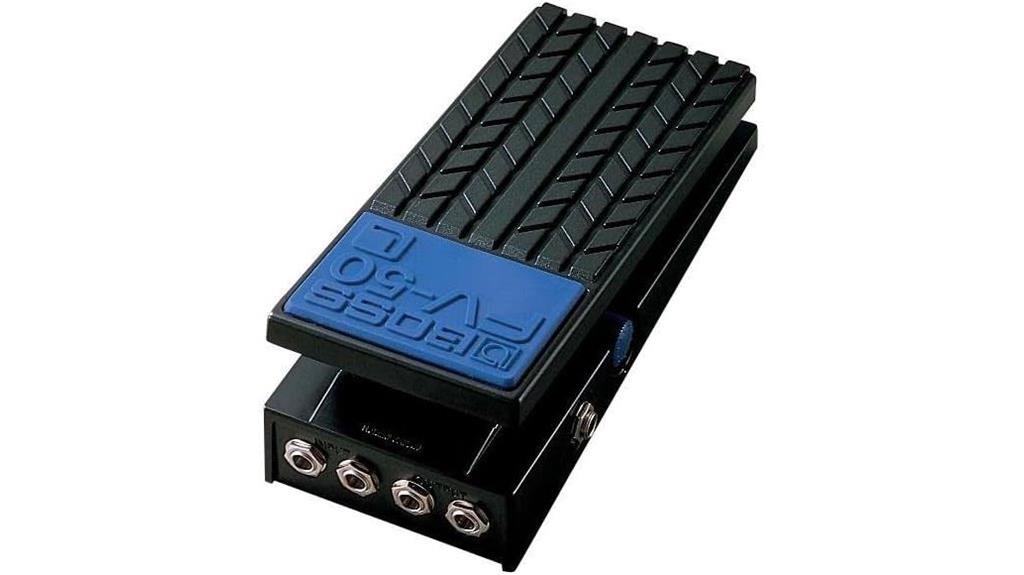
The Boss FV-50L Stereo Volume Pedal stands as the premier choice for keyboardists and synthesizer players who demand professional-grade volume control with stereo functionality, though its low-impedance design makes it equally suitable for bassists seeking precise signal management. You’ll appreciate the dual inputs and outputs that maintain signal integrity while providing seamless stereo operation. The compact 86mm x 200mm x 54mm dimensions won’t dominate your pedalboard, and the dedicated tuner output enables silent tuning during performances. While some users report occasional signal cutouts after extended use, the adjustable minimum volume knob and lightweight design deliver reliable functionality for most applications.
Best For: Keyboardists, synthesizer players, and bassists who need professional stereo volume control with precise signal management and space-saving pedalboard design.
Pros:
- Dual inputs/outputs maintain signal integrity with seamless stereo operation
- Compact dimensions (86mm x 200mm x 54mm) save valuable pedalboard space
- Dedicated tuner output allows silent tuning during live performances
Cons:
- Some users report intermittent signal cutouts after extended use
- Durability concerns with reports of malfunctioning after a few months of heavy use
- Low-impedance design limits compatibility primarily to keyboards and bass rather than guitars
Quick-Lok VP-2611 Volume Pedal for Keyboard or Guitar (Mono)
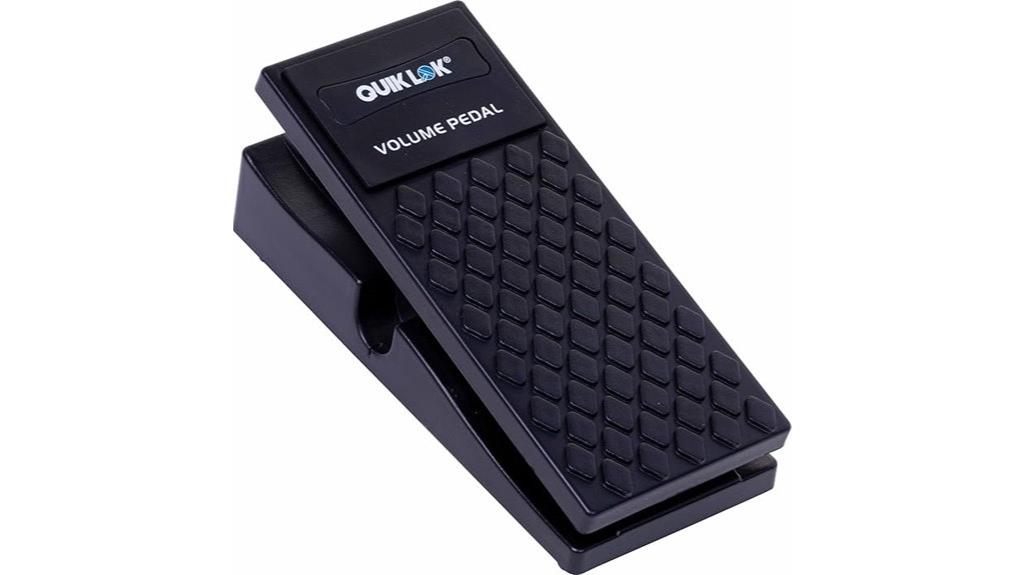
Budget-conscious musicians who need reliable volume control without breaking the bank will find the Quick-Lok VP-2611 particularly appealing, as this mono volume pedal delivers essential functionality at a fraction of the cost you’d expect to pay for similar gear. You’ll get smooth, noise-free volume adjustment without tone loss, thanks to its custom potentiometer and passive design that requires no batteries or power adapters. While the heavy metal base provides decent stability and the construction feels reasonably solid for the price point, you should know that some users report durability concerns over time.
Best For: Budget-conscious musicians who need a basic, reliable volume pedal for guitar or keyboard without complex features or high-end brand pricing.
Pros:
- Passive design requires no batteries or power adapters for simple plug-and-play operation
- Smooth, noise-free volume control with no tone loss or frequency changes
- Heavy metal base provides stability during use at an affordable price point
Cons:
- Some users report durability issues and early failures over time
- Quality control concerns with construction materials and overall build
- Volume sweep linearity issues at lower settings affecting precise control
Hotone Volume Expression 2 in 1 Guitar Effects Pedal
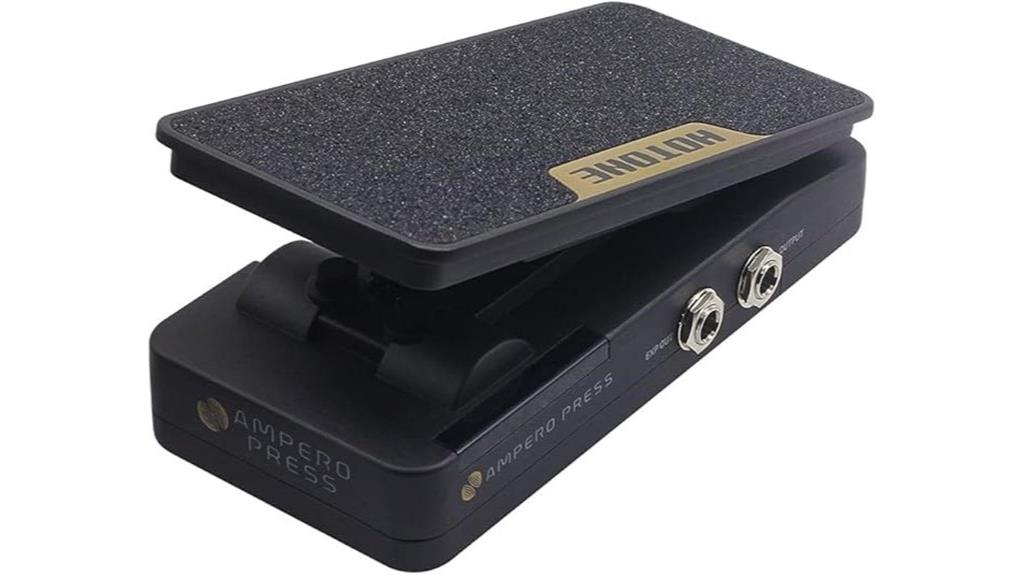
Musicians seeking a dual-purpose solution that eliminates pedal board clutter will find the Hotone Volume Expression 2 in 1 Guitar Effects Pedal delivers exactly what its name promises, combining both volume control and expression pedal functionality in a single, compact aluminum alloy housing. This passive design requires no power supply, though you’ll need TRS cables for peak performance since standard guitar cables won’t cut it here. The independent output jacks let you route signals separately, and while the high-quality potentiometer provides precise response, you can’t control volume and wah effects simultaneously without manual switching, which honestly limits its versatility somewhat.
Best For: Musicians who want to save pedalboard space by combining volume and expression control in one durable, passive pedal but don’t need simultaneous control of both functions.
Pros:
- Compact dual-functionality design eliminates the need for separate volume and expression pedals, saving valuable pedalboard real estate
- Passive design requires no power supply, reducing setup complexity and power consumption concerns
- Solid aluminum alloy construction with high-quality potentiometer ensures durability and precise response
Cons:
- Cannot control volume and wah effects simultaneously without manual switching, limiting real-time versatility
- Requires TRS cables for optimal performance, which may necessitate additional cable purchases beyond standard guitar cables
- Some users report limitations with volume dynamics and swells compared to dedicated volume pedals
Factors to Consider When Choosing a Volume Guitar Pedal
When I’m helping guitarists choose the right volume pedal, I’ve learned that five critical factors can make or break your experience and determine whether you’ll love or regret your purchase. These considerations—pedal size and footprint, power requirements and connectivity, signal path and bypass options, taper control and range capabilities, plus overall build quality and durability—directly impact how the pedal performs in your specific setup, whether you’re playing bedroom jams or stadium shows. I’ll walk you through each factor so you can make an informed decision that matches your playing style, pedalboard real estate, and long-term reliability needs.
Pedal Size and Footprint
One overlooked factor that I’ve learned can make or break your pedalboard setup is the physical size and footprint of your volume pedal, especially since these units tend to be among the bulkier effects in your signal chain. I’ve found that compact models like the Rock Stock Nano, which measures 50% smaller than standard tuners, can save precious real estate without sacrificing functionality. Weight matters too – both the AZOR SAG OVER DRIVE and Donner Tuner Pedal clock in at just 8.8 ounces, making transport effortless. The Ernie Ball VP JR’s dimensions of 3.5″ W x 10″ L x 2 3/8″ H demonstrate how thoughtful sizing accommodates cramped boards, while ultra-slim options like the Hotone Volume Expression at 3.19 x 6.38 x 2.01 inches integrate seamlessly into existing setups.
Power Requirements and Connectivity
The power requirements for volume pedals split into two distinct categories that’ll directly impact your setup complexity and pedalboard configuration. Active pedals typically require 9V DC power adapters, which manufacturers rarely include in the package, forcing you to purchase additional components for basic functionality. I’ve found passive pedals offer simpler plug-and-play operation without external power needs, making them ideal for streamlined setups.
Connectivity demands careful attention to jack compatibility, as pedals utilize different outputs including standard 1/4-inch and TRS connections for expression functionality. Using appropriate cables becomes essential for dual-use pedals, where TRS connections greatly enhance response and performance. I always verify impedance requirements between active and passive designs, since compatibility issues can arise when linking different instruments and equipment configurations.
Signal Path and Bypass
Beyond the fundamental connectivity considerations lies the critical matter of signal path integrity, which determines whether your guitar’s tone survives the journey through your volume pedal unscathed. I’ve learned that True Bypass switching design stands as the gold standard here, ensuring your original signal remains completely unaltered when the pedal isn’t actively engaged, preventing any unwanted tonal coloration or loss. The potentiometer quality directly impacts how smoothly and accurately you’ll control volume adjustments throughout your signal chain, so don’t skimp on this component. I always recommend avoiding pedals that introduce signal interference or noise unless they feature quality components, as these issues can seriously compromise your sound integrity during critical performances when reliability matters most.
Taper Control and Range
While signal integrity forms the foundation of any quality volume pedal, taper control determines how that clean signal responds to your foot movements, making it perhaps the most performance-critical feature you’ll encounter. I’ve found that switchable taper options dramatically expand a pedal’s versatility, allowing me to shift between gradual ambient swells and aggressive dynamic cuts within the same song. The micro taper switch, which I initially dismissed as marketing fluff, actually provides essential customization for different playing styles and venues. Range capability affects how subtle or dramatic your volume changes can be, and I’ve learned that insufficient range will limit your expressive potential, especially when adapting between delicate fingerpicking passages and full-band sections during live performances.
Build Quality and Durability
Since volume pedals endure more physical abuse than virtually any other effect in your signal chain, I’ve learned that build quality isn’t just about aesthetics—it’s about whether your pedal will survive the first month of regular gigs. I prioritize aluminum construction over plastic housings, though heavy-duty plastics can work if they’re properly reinforced around stress points. Non-slip deck mats and aggressive tread patterns aren’t luxuries—they’re necessities when you’re performing under stage lights with sweaty feet. I always check cycle test reports and user reviews focusing on potentiometer longevity, since volume pots fail more frequently than footswitches in my experience. Customer feedback about mechanical failures during intensive use tells me everything I need to know about real-world durability.
On a final note
I’ve tested countless volume pedals throughout my playing career, and these eight options represent the cream of the crop for different budgets and applications. Whether you’re seeking the robust build quality of the Ernie Ball VP JR, the innovative dual functionality of the SONICAKE VolWah, or the professional stereo capabilities of the Boss pedal, there’s something here that’ll elevate your tone control game considerably.




